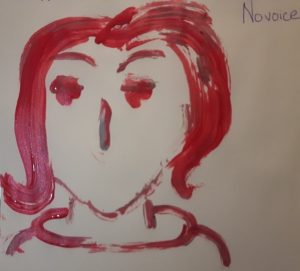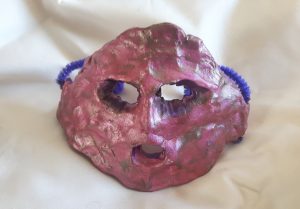9 Finding Your Voice: Adverse Events, Trauma and “When Bad Things Happen”
This section examines the association between adverse events and trauma and the links and associations to the development of an eating disorder.
Finding My Voice: My Story with a Health Care Professional
Below, Janet shares a poem she wrote about her experiences with disclosing adverse events to health care professional and the emotions associated with them:
I have a story to tell you, well – maybe I will tell you.
I asked, “are you telling me adverse events are linked to my eating disorder?”
I have never told anyone this information and I do not yet trust you to tell you the whole story.
No one has heard this story before.
I am really upset that you are saying my story may be associated to my eating disorder.
I am angry now…I want to blame myself, or others.
In response, I cry on the inside and sometimes on the outside.
I am flooded with emotions, sadness, loneliness, and I’m tired.
I ran, hid, silence prevailed, and I am near death. Will I ever come to trust? – Janet
Writing poems is a form of poetic sharing that may be used to tell a story. This is a form of expression that can be used in your journal. In time and alongside my family, friends and health care professionals I created, journaled, painted, and sketched my way to health and found my voice. In time, you too can make the links – healing occurs in time and with hard work.

Finding Your Voice: Trauma and When Bad Things Happen
Trauma is when bad things happen, or have happened (Mate, 2018). Asking about adverse events in your life may be part of the health assessment questions discussed with you by a health care professionals. This is an important part of assessment as you and your team come to understand the complexity of your eating disorder. Those who struggle or have struggled who have an eating disorder may have experienced Adverse Childhood Experiences (ACEs) and trauma, and yet not all children who experience ACEs or trauma develop an eating disorder. Overall, the likelihood does increase when trauma or ACEs are present.
So what exactly are ACEs?
Adverse childhood experiences take many forms. The Centers for Disease Control and Prevention (CDC, 2023) have resources that are detailed in descriptions, facts, and how to support recovery. Try the CDC link to read and understand the links between trauma and how you are presently living.
Trauma can be experienced across all age groups and in many settings. There is a growing body of literature that explains the association between trauma, abuse, and neglect including – sexual, emotional, physical, and social, and the co-relation to the risk of developing an eating disorder (Brewerton, 2007; Guilaume et al., 2016; van der Kolk, 2014). As well, Brewerton (2007), reminds us that persons with eating disorders often experience an eating disorder and a mental health issue(s) at the same time (concurrent). Mental health issues may include depression, anxiety, self-harm activities, substance use such as prescribed and non-prescribed medications and substances, alcohol, or drugs, and mood or personality disorders (this list is not all-inclusive).
Eating Disorders and Links to Trauma
Most times we think of trauma in terms of abuse, whether it be sexual, physical, or emotional abuse, with sexual abuse being the most common. The reality is, that trauma is any form of abuse, harassment, or bullying that creates anxiety or some degree of Post-Traumatic Stress Disorder (PTSD).
Our brain responds to traumatic experiences which results in changes to our brain structures (Mate, 2018). These changes make it hard to process memories and emotions. The brain is so focused on survival that it doesn’t have time to process thoughts and emotions (Katz, 2018). Thus, many survivors are unable to process these experiences effectively because the brain cannot think when it is constantly in survival mode. The reliance on food rituals can predominate and the resulting control of food intake is used instead of effective coping mechanisms. As well, sometimes we are active and over-active, running, hiking, and swimming more than is healthy. This too may be how we cope.
Long-term exposure to trauma not only keeps one in a “fight, flight or freeze” mode but also reduced neurotransmitters responsible for mood and anxiety. New or additional stress can make symptoms more predominant because they create new experiences that cannot be processed effectively. The added anxiety prompts the need to control emotion with unhealthy coping strategies (Katz, 2018).
Stress can trigger uncomfortable emotions as well and cause a relapse. Stress releases cortisol which activates survival mode and prevents us from processing information well. Persistent stress causes those cortisol levels to remain high, triggering a constant fear. It does not mean that everyone who experiences stress will revert to controlling food intake to manage their stress or anxiety. It does make us more susceptible.
Creation Space: Ask for Support
Understanding if you have any links between adverse events, trauma, and your eating disorder is hard, tiring, and complex work. This work cannot be done alone. Sometimes things are okay and then you have times when you take a step back to rest and become energized. It is important to seek a trained and trusted professional to be in support and to come alongside you.
- What do you think about asking for help to discuss uncomfortable topics?
- On a scale of 1 (not asking for help) to 10 (asking for help), what would you score your tendency to ask for support?
If you decide to, and alongside a trusted person you can explore the Canadian Association for Mental Health (CAMH, 2022) webpages on adverse childhood events. CAMH has posted online a screening tool that discusses Adverse Childhood Experiences. It is important that you work with a trained, trusted healthcare provider when completing this tool. You may respond in various ways to the questions in this screening tool.
Asking for support….
Janet: “I struggled to be authentic and ask for help. I could talk circles around people and for some years because of this I did not make progress in making the association between adverse events and the eating disorder. I often felt as though I did not have a voice” “Yet, during these dark and chaotic times, a trusted physician gave me a copy of The Velveteen Rabbit (Williams, 1992). Upon reading this book, I marked up the following section from this amazing book. Today, I still return to this section of The Velveteen Rabbit:
“What is REAL?” asked the Rabbit one day, when they [Skin Horse] were lying side by side near the nursery fender, before Nana came to tidy the room.
“Does it mean having things that buzz inside you and a stick-out handle?”
“Real isn’t how you are made, ” said the Skin Horse. ‘It’s a thing that happens to you. When a child loves you for a long, long time, not just to play with, but REALLY loves you, then you become real.
“Does it hurt?” asked the Rabbit.
“Sometimes,” said the Skin Horse, for he was always truthful. ‘When you are real you don’t mind being hurt.”
“Does it happen all at once, like being wound up,” he asked, “or bit by bit?”
“It doesn’t happen all at once,” said the Skin Horse. “You become. It takes a long time. That’s why is doesn’t often happen to people who break easily, or have sharp edges, or who have to be carefully kept. Generally, by the time you are Real, most of your hair has been loved off, and your eyes drop out and you get loose in the joints and very shabby. But these things don’t matter at all, because once you are Real you can’t be ugly, except to people who don’t understand.”
(Williams, 1992, pp. 7-8)
Creation Space
- Upload your favorite toy from your childhood.
- What are you thinking and feeling today, about your toy?
Creation Space: Finding A Voice – My Voice
In response to this topic, I created the following clay mask using clay from a craft store. This mask is significant as it has a mouth. I titled this work ‘Finding Voice’. The pink/red for me was symbolic of my internal pain and of not talking aloud during difficult times.

- Can you create a picture that reflects your experiences with adverse events? Take a picture of your creation and upload it!
- When you sit and ponder the creation, does it help you find your voice through color and media?
or
- Journal about what you are thinking and feeling:
Creation Space
- Journal, how you are feeling about the journal process today?
“After I told my story of trauma and pain, I was flooded with emotion. It had been the first time that I allowed myself to speak the words, reflect on the truth, and heal. Of course, acknowledging this pain caused additional discomfort. I wanted to re-bury the pain, make it all go away. It was with a trusted therapist that I came to realize that by peeling back the layers of emotion, I couldn’t rebury the pain or emotion it was generating. I had to now manage this discomfort, force myself to confront the pain, and manage my emotions”.
Your therapist will guide you on this journey as you explore your relationship of food to emotion. Rest assured, you won’t be alone in processing your thoughts and emotions.

